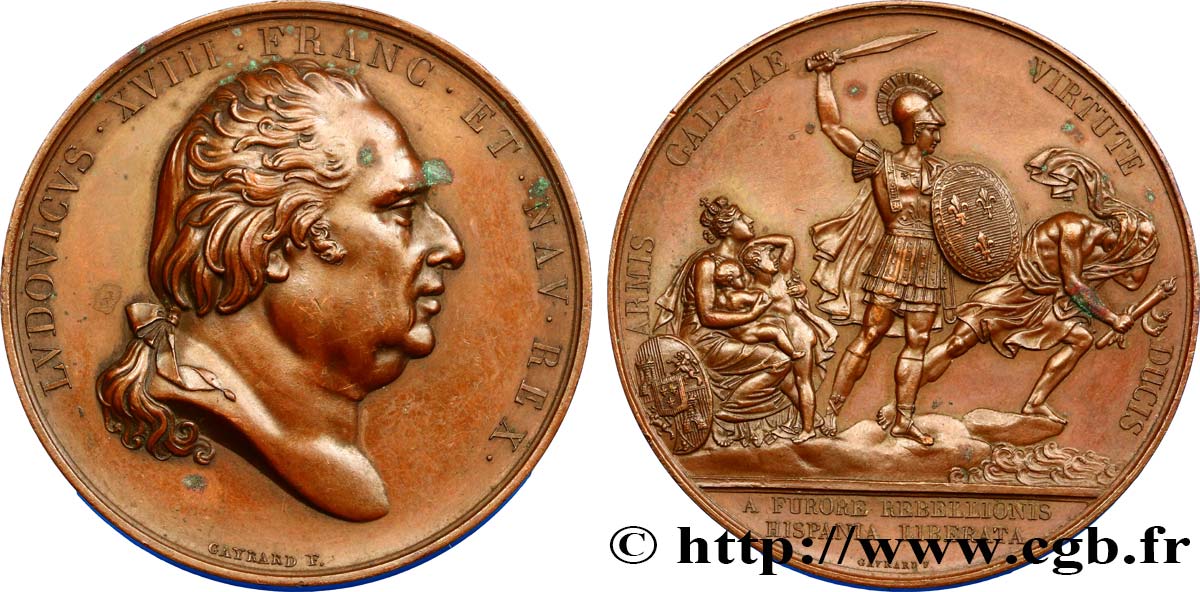E-auction 488-399453 - fme_412461 - LUDWIG XVIII Médaille, Restauration du trône d’Espagne
Sie müssen angeschlossen sein und von cgb.fr genehmigt werden, um in einer E-Auktion teilzunehmen.Melden Sie sich an, um zu wetten..Die Kontobestätigungen sind innerhalb von 48 Stunden nach Ihrer Anmeldung gemacht.Warten Sie nicht bis die letzten zwei Tage vor dem Abschluss eines Verkaufs, um Ihre Registrierung abzuschließen. Klickend "BIETEN" verpflichten Sie sich vertraglich, diesen Artikel zu kaufen und Sie nehmen ohne Reserve die allgemeinen Verkaufsbedingungen für den e-auctions zu cgb.fr an.
Der Verkauf wird an der Zeit auf der Übersichtsseite angezeigt geschlossen werden. Angebote, die nach der Schließung Zeit empfangen sind, werden nicht gültig.
Bitte beachten Sie, dass die Fristen für die Einreichung Ihres Angebots auf unsere Server können variieren und es kann zur Ablehnung Ihres Angebots entstehen, wenn es in den letzten Sekunden des Verkaufs gesendet wird. Die Angebote sollen mit ganzer Zahl ausgeführt sein, Sie können Kommas oder des Punktes in Ihrem Angebot nicht erfassen. Bei Fragen klicken Sie hier, um einen Blick auf die FAQ E-Auktionen.
KEINE ANSCHAFFUNGSKOSTEN FÜR DIE KÄUFER.
KEINE ANSCHAFFUNGSKOSTEN FÜR DIE KÄUFER.
| Schätzung : | 150 € |
| Preis : | 46 € |
| Höchstgebot : | 56 € |
| Verkaufsende : | 22 August 2022 17:52:00 |
| Bieter : | 10 Bieter |
Type : Médaille, Restauration du trône d’Espagne
Datum: 1823
Name der Münzstätte / Stadt : Espagne
Metall : Bronze
Durchmesser : 51 mm
Stempelstellung : 12 h.
Graveur Gayrard
Gewicht : 68 g.
Rand lisse
Punze : sans poinçon
Kommentare zum Erhaltungszustand:
Patine marron hétérogène avec des concrétions vertes. Légère usure. Présence d equelques coups
N° im Nachschlagewerk :
Vorderseite
Titulatur der Vorderseite LVDOVICVS. XVIII. FRANC. ET. NAV. REX..
Beschreibung Vorderseite Tête de Louis XVIII à droite, signé GAYRARD F. .
Rückseite
Titulatur der Rückseite ARMIS GALLIAE - VIRTUTE DUCIS // A FURORE REBELLIONIS/ HISPANIA LIBERATA.
Beschreibung Rückseite Guerrier debout vêtu à l'antique brandissant le glaive, le bouclier timbré de trois lys, repoussant l'ennemi vers la mer ; à gauche, l'Espagne assise retenant deux enfants, à ses pieds un bouclier timbré aux armes de Castille et de Léon, signé GAYRARD F. .
Kommentare
Médaille signe GAYRARD F.
Raymond Gayrard, sculpteur-graveur, (Rodez, 25 octobre 1777-1858), est l'élève de François Rude et David d'Angers. Il expose au salon de Paris en 1827 et poursuit ses expositions tout au long de sa vie. En 1834, il obtient la deuxième place au concours et la médaille de première classe en 1846 et 1848. Il expose pour la dernière fois en 1855. Apprécié de la haute société française, il exécute beaucoup de bustes de personnalités contemporaines. Il est est également sculpteur animalier.
Paul Joseph Raymond Gayrard, dit Raymond Gayrard, né le 3 septembre 1807 à Clermont-Ferrand (Puy-de-Dôme) et mort en 1855 à Enghien-les-Bains (Val-d'Oise), est un sculpteur et graveur-médailleur français. Il étudie à un âge précoce avec son père.
La restauration absolutiste en Espagne, s'étendant de 1814 à 1833, est une période au cours de laquelle le pays connaît un rétablissement de la monarchie absolue des Bourbons.
Après la guerre d'indépendance contre l'occupant français, les Cortès se réunissent à Madrid en octobre 1813. Peu après, Napoléon reconnaît Ferdinand VII comme roi d'Espagne par le traité de Valençay. Fort du soutien de la majeure partie de la population espagnole, celui-ci rentre dans sa capitale, le 22 mars 1814, par le chemin de Valence. Il reçoit alors, de la main d'un groupe de fidèles de la monarchie le manifeste des Perses, une déclaration favorable à une restauration absolutiste.
Début 1823, la Sainte Alliance décide d'intervenir en Espagne, ainsi qu'elle l'a déjà fait à Naples et au Piémont. Le 22 janvier un traité secret est signé qui permet à la France d'envahir l'Espagne pour rétablir Ferdinand VII en monarque absolu.
Medal signed GAYRARD F.
Raymond Gayrard, sculptor-engraver, (Rodez, October 25, 1777-1858), was a student of François Rude and David d'Angers. He exhibited at the Paris Salon in 1827 and continued to exhibit throughout his life.. In 1834 he obtained second place in the competition and the first class medal in 1846 and 1848.. He exhibited for the last time in 1855. Appreciated by French high society, he executed many busts of contemporary personalities. He is also an animal sculptor.
Paul Joseph Raymond Gayrard, known as Raymond Gayrard, born on September 3, 1807 in Clermont-Ferrand (Puy-de-Dôme) and died in 1855 in Enghien-les-Bains (Val-d'Oise), was a French sculptor and engraver-medalist. He studied at an early age with his father.
The absolutist restoration in Spain, lasting from 1814 to 1833, was a period during which the country experienced a reestablishment of the absolute Bourbon monarchy..
After the war of independence against the French occupiers, the Cortes met in Madrid in October 1813.. Shortly after, Napoleon recognized Ferdinand VII as King of Spain by the Treaty of Valençay. With the support of the majority of the Spanish population, he returned to his capital on March 22, 1814, via Valencia.. He then received, from the hand of a group of loyalists of the monarchy, the manifesto of the Persians, a declaration in favor of an absolutist restoration.
At the beginning of 1823, the Holy Alliance decided to intervene in Spain, as it had already done in Naples and Piedmont.. On January 22, a secret treaty was signed that allowed France to invade Spain and reinstate Ferdinand VII as absolute monarch.
Raymond Gayrard, sculpteur-graveur, (Rodez, 25 octobre 1777-1858), est l'élève de François Rude et David d'Angers. Il expose au salon de Paris en 1827 et poursuit ses expositions tout au long de sa vie. En 1834, il obtient la deuxième place au concours et la médaille de première classe en 1846 et 1848. Il expose pour la dernière fois en 1855. Apprécié de la haute société française, il exécute beaucoup de bustes de personnalités contemporaines. Il est est également sculpteur animalier.
Paul Joseph Raymond Gayrard, dit Raymond Gayrard, né le 3 septembre 1807 à Clermont-Ferrand (Puy-de-Dôme) et mort en 1855 à Enghien-les-Bains (Val-d'Oise), est un sculpteur et graveur-médailleur français. Il étudie à un âge précoce avec son père.
La restauration absolutiste en Espagne, s'étendant de 1814 à 1833, est une période au cours de laquelle le pays connaît un rétablissement de la monarchie absolue des Bourbons.
Après la guerre d'indépendance contre l'occupant français, les Cortès se réunissent à Madrid en octobre 1813. Peu après, Napoléon reconnaît Ferdinand VII comme roi d'Espagne par le traité de Valençay. Fort du soutien de la majeure partie de la population espagnole, celui-ci rentre dans sa capitale, le 22 mars 1814, par le chemin de Valence. Il reçoit alors, de la main d'un groupe de fidèles de la monarchie le manifeste des Perses, une déclaration favorable à une restauration absolutiste.
Début 1823, la Sainte Alliance décide d'intervenir en Espagne, ainsi qu'elle l'a déjà fait à Naples et au Piémont. Le 22 janvier un traité secret est signé qui permet à la France d'envahir l'Espagne pour rétablir Ferdinand VII en monarque absolu.
Medal signed GAYRARD F.
Raymond Gayrard, sculptor-engraver, (Rodez, October 25, 1777-1858), was a student of François Rude and David d'Angers. He exhibited at the Paris Salon in 1827 and continued to exhibit throughout his life.. In 1834 he obtained second place in the competition and the first class medal in 1846 and 1848.. He exhibited for the last time in 1855. Appreciated by French high society, he executed many busts of contemporary personalities. He is also an animal sculptor.
Paul Joseph Raymond Gayrard, known as Raymond Gayrard, born on September 3, 1807 in Clermont-Ferrand (Puy-de-Dôme) and died in 1855 in Enghien-les-Bains (Val-d'Oise), was a French sculptor and engraver-medalist. He studied at an early age with his father.
The absolutist restoration in Spain, lasting from 1814 to 1833, was a period during which the country experienced a reestablishment of the absolute Bourbon monarchy..
After the war of independence against the French occupiers, the Cortes met in Madrid in October 1813.. Shortly after, Napoleon recognized Ferdinand VII as King of Spain by the Treaty of Valençay. With the support of the majority of the Spanish population, he returned to his capital on March 22, 1814, via Valencia.. He then received, from the hand of a group of loyalists of the monarchy, the manifesto of the Persians, a declaration in favor of an absolutist restoration.
At the beginning of 1823, the Holy Alliance decided to intervene in Spain, as it had already done in Naples and Piedmont.. On January 22, a secret treaty was signed that allowed France to invade Spain and reinstate Ferdinand VII as absolute monarch.








 Berichten über einen Fehler
Berichten über einen Fehler Die Seite drucken
Die Seite drucken Teilen meiner Auswahl
Teilen meiner Auswahl Stellen Sie eine Frage
Stellen Sie eine Frage Einlieferung/Verkauf
Einlieferung/Verkauf
 Details
Details









